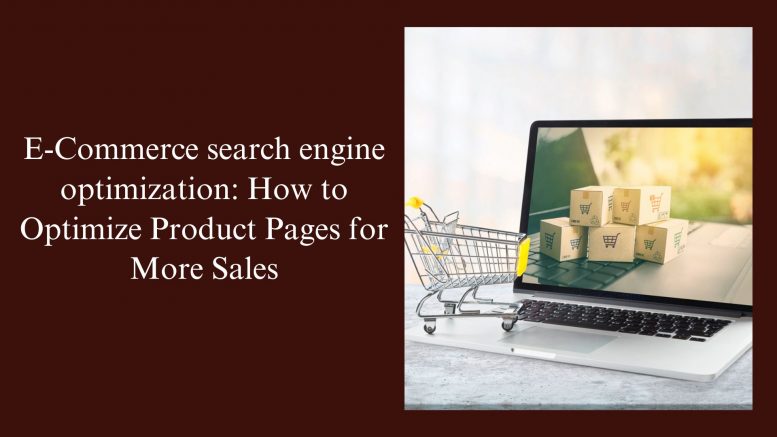In the aggressive global of e-commerce, optimizing product pages is essential for riding web page site visitors and increasing conversions. By imposing powerful search engine advertising and marketing strategies, you could improve searching for engine scores, enchantment to functionality customers, and boost income. Here’s a way to optimize your e-trade product pages for better average overall performance.
How to Optimize E-Commerce Product Pages for Higher Sales
1.Conduct Thorough Keyword Research
Keyword studies is the muse of e-trade search engine optimization. Use equipment like Google Keyword Planner, Ahrefs, or SEMrush to become aware of applicable key phrases that healthy man or woman are seeking for motive. Focus on:
- Primary Keywords: The main product name or category.
- Long-Tail Keywords: Specific phrases that potential buyers may use.
- LSI Keywords: Related terms that add context to your product.
- Competitor Keywords: Analyze top competitors and find gaps in their keyword strategy.
- Seasonal Keywords: Identify trends and seasonal terms that can boost sales during peak times.
2.Optimize Product Titles and Meta Descriptions
The name and meta description appear in seek outcomes and need to be engaging, descriptive, and keyword-wealthy.
- Title Tags: Keep them below 60 characters and include the primary key-word.
- Meta Descriptions: Limit to 150-a hundred and sixty characters with a name to action to entice clicks.
- Avoid Keyword Stuffing: Ensure the title reads certainly and remains user-friendly.
- Use Brand Name: If applicable, include your logo call in the name for popularity.
3.Use High-Quality Images and Videos
Visual content plays a crucial role in e-commerce SEO and conversion rates. Ensure your images:
- Are high resolution and professionally shot.
- Have optimized file names (e.g., “leather-handbag-black.jpg”).
- Use alt text with descriptive keywords for better image search visibility.
- Include product demo videos for enhanced engagement.
- Utilize 360-degree product images for better user experience.
- Optimize image file sizes to ensure faster loading times.
4.Write Unique and Persuasive Product Descriptions
Avoid using manufacturer descriptions that may be duplicated across multiple websites. Instead:
- Write original, compelling content that highlights benefits and features.
- Incorporate targeted keywords naturally.
- Use bullet points for readability.
- Address customer pain points and how your product solves them.
- Include storytelling elements to make descriptions more engaging.
- Clearly outline dimensions, specifications, and key differentiators.
5.Implement Schema Markup for Rich Snippets
Adding dependent facts markup (Schema.Org) facilitates search engines like google understand product information like charge, availability, and scores. This will increase the probabilities of your product appearing in wealthy snippets, enhancing CTR.
- Product Schema: Include product details such as price, SKU, and availability.
- Review Schema: Add customer review markup to highlight ratings.
- FAQ Schema: Implement common questions to enhance rich results.
6.Optimize URL Structure
A clean and keyword-rich URL improves SEO and user experience. Follow these best practices:
- Keep URLs short and readable (e.g., “yoursite.com/mens-running-shoes”).
- Use hyphens instead of underscores.
- Avoid unnecessary parameters or session IDs.
- Include relevant keywords without making URLs too long.
7.Improve Page Load Speed
Slow-loading product pages lead to higher bounce rates and lost sales. Optimize speed by:
- Compressing images using tools like TinyPNG.
- Enabling browser caching.
- Using a Content Delivery Network (CDN).
- Minimizing HTTP requests and reducing unnecessary scripts.
- Implementing lazy loading for images and videos.
- Using efficient hosting solutions for better site performance.
8.Enhance Mobile Friendliness
With cellular trade on the upward push, making sure a unbroken shopping enjoy on cell devices is critical. Follow these steps:
- Use a responsive design.
- Optimize button sizes for touchscreens.
- Improve navigation for easy browsing.
- Ensure fast-loading pages on mobile with AMP (Accelerated Mobile Pages).
- Remove intrusive pop-ups that affect mobile usability.
9.Add Customer Reviews and Ratings
Product reviews build trust and influence buying decisions. Encourage customers to leave reviews by:
- Sending follow-up emails after purchase.
- Offering incentives like discounts.
- Displaying both positive and negative feedback for authenticity.
- Allowing user-generated content like photo reviews.
- Using third-party review platforms for additional credibility.
10.Leverage Internal Linking
Linking to related products and category pages improves user engagement and SEO. Best practices include:
- Adding “Related Products” or “Customers Also Bought” sections.
- Linking to blog posts for additional product insights.
- Ensuring anchor text is descriptive and keyword-rich.
- Implementing breadcrumbs to decorate site navigation.
11.Implement a Strong Call-to-Action (CTA)
A clear CTA directs customers toward making a purchase. Examples include:
- “Add to Cart”
- “Buy Now”
- “Limited Stock – Order Today!”
Ensure the CTA button is visually prominent and strategically placed.
- Use contrasting colors for CTA buttons to stand out.
- Add urgency phrases like “Only 2 Left in Stock!”
- Place CTA buttons above the fold for better visibility.
12.Enhance Trust Signals and Security
Online buyers need warranty that your keep is stable and sincere. Strengthen credibility with the aid of:
- Displaying security badges (SSL, Trustpilot, BBB Accreditation).
- Offering clear return and refund policies.
- Providing multiple secure payment options.
- Showcasing testimonials and user success stories.
Conclusion
Optimizing e-trade product pages is an ongoing method that entails key-word research, technical enhancements, and user experience enhancements. By following those techniques, you may growth organic traffic, improve conversions, and maximize sales. Implement these great practices today and stay ahead of your opposition in the ever-evolving e-commerce landscape
For expert digital marketing solutions tailored to boost your online store’s performance, visit OGI Technology.


Be the first to comment on "E-Commerce search engine optimization: How to Optimize Product Pages for More Sales"